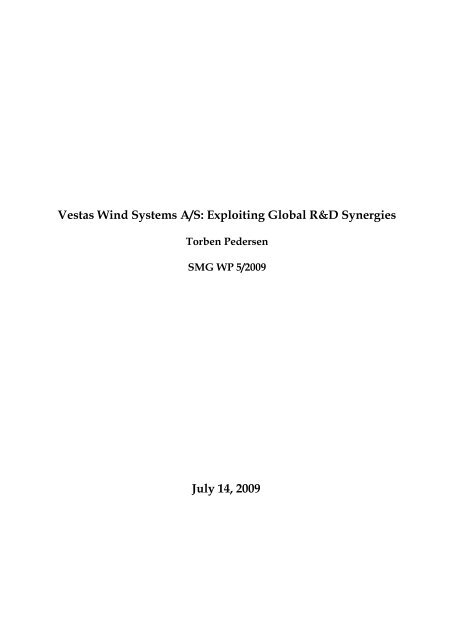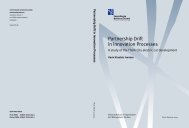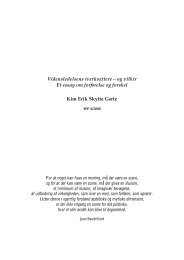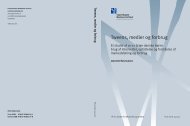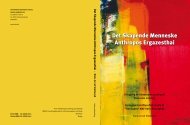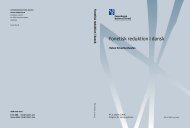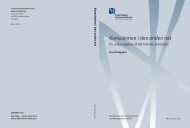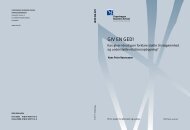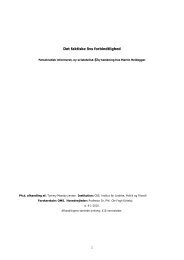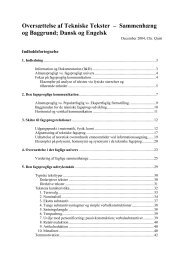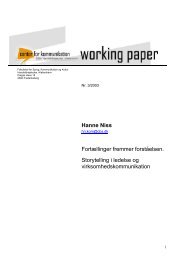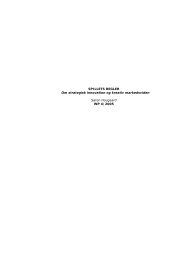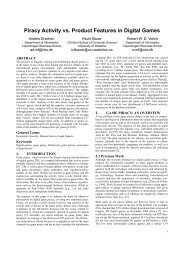July 14, 2009 Vestas Wind Systems A/S - OpenArchive@CBS ...
July 14, 2009 Vestas Wind Systems A/S - OpenArchive@CBS ...
July 14, 2009 Vestas Wind Systems A/S - OpenArchive@CBS ...
Create successful ePaper yourself
Turn your PDF publications into a flip-book with our unique Google optimized e-Paper software.
<strong>Vestas</strong> <strong>Wind</strong> <strong>Systems</strong> A/S: Exploiting Global R&D Synergies<br />
Torben Pedersen<br />
SMG WP 5/<strong>2009</strong><br />
<strong>July</strong> <strong>14</strong>, <strong>2009</strong>
978-87-91815-12-6<br />
SMG Working Paper No. 5/<strong>2009</strong><br />
<strong>July</strong> <strong>14</strong>, <strong>2009</strong><br />
ISBN: 978-87-91815-46-1<br />
Center for Strategic Management and Globalization<br />
Copenhagen Business School<br />
Porcelænshaven 24<br />
2000 Frederiksberg<br />
Denmark<br />
www.cbs.dk/smg
<strong>Vestas</strong> <strong>Wind</strong> <strong>Systems</strong> A/S: Exploiting Global R&D Synergies<br />
<strong>Vestas</strong> <strong>Wind</strong> <strong>Systems</strong> A/S: Exploiting Global R&D Synergies<br />
Much had happened since the CEO of <strong>Vestas</strong> <strong>Wind</strong> <strong>Systems</strong> A/S, Ditlev Engel, broadcast the<br />
company’s new corporate strategy – The Will to Win 2005-2008 – from headquarters in<br />
Randers, Denmark to all <strong>Vestas</strong> employees worldwide in 2005. <strong>Vestas</strong>, the market-leading<br />
producer of high-tech wind turbines, had since a merger the year before with a Danish turbine<br />
producer experienced financial difficulties, and management was therefore replaced with<br />
fresh leadership that could bring the Danish company to new heights. With the new<br />
management came a radical reorganization and the announcement of several new strategic<br />
initiatives. As Engel stated, “These initiatives are aimed at increasing effectiveness in all areas<br />
of <strong>Vestas</strong>’s business. We will professionalize our dialogue with the customers, we will<br />
improve the quality of our products and we will be much more effective in all that we do.” 1<br />
The charismatic CEO also argued that “by the implementation of The Will to Win, we create a<br />
new global <strong>Vestas</strong>. This work will, no doubt, be exciting and very hard. At the same time, it<br />
will require the will to change in all of us and I am confident that we at <strong>Vestas</strong> can meet this<br />
challenge.” 2<br />
Among the initiatives was the establishment of the <strong>Vestas</strong> Technology R&D business<br />
unit, headed by Finn Strøm Madsen. Inexperienced in the field of wind energy, Madsen was<br />
determined to achieve global leadership in all core technology areas and, consequently,<br />
strengthen a core competence for the company. By 2008, Madsen had succeeded in setting up<br />
a global R&D network with R&D centers in Denmark, the UK, Singapore, and India, and in<br />
early <strong>2009</strong>, a center was opened in the US. <strong>Vestas</strong> Technology R&D accounted for EUR 228<br />
million in expenditures (3.7 percent of the consolidated revenue) in 2008, which was 79.5<br />
percent higher than in 2007. That same year, <strong>Vestas</strong> announced a new corporate strategy<br />
known as the No. 1 in Modern Energy strategy. With this strategy, the company – as market<br />
leader – committed itself to promoting the wind industry as a whole and to putting wind<br />
energy on par with oil and gas. In addition, the strategy highlighted <strong>Vestas</strong> as a high-tech<br />
company and put a greater emphasis on its technological innovations.<br />
Despite impressive growth in recent years – the amount of energy delivered by <strong>Vestas</strong><br />
increased by 75 percent since 2005 and its revenue had grown by 68 percent – Finn Strøm<br />
Madsen faced a dilemma. The number of employees in Technology R&D was at a record<br />
high, the R&D network already encompassed five development facilities around the world,<br />
1 <strong>Vestas</strong> press release, “Strategic Plan 2005-2008”, 05/26/2005.<br />
2 <strong>Vestas</strong> press release, “Strategic Plan 2005-2008”, 05/26/2005.<br />
1
<strong>Vestas</strong> <strong>Wind</strong> <strong>Systems</strong> A/S: Exploiting Global R&D Synergies<br />
and further expansion was planned. On top of that, the network had extensive links to external<br />
research centers and universities. The task of coordinating and, consequently, capitalizing on<br />
the R&D network was growing more complex and complicated as the network expanded.<br />
Identifying novel, profitable competences and innovations around the world, managing the<br />
interfaces between different research units and resources, and exploiting synergies were<br />
challenges Finn Strøm Madsen faced. Even though <strong>Vestas</strong> had shown positive growth,<br />
competition from different types of companies was growing considerably due to the<br />
attractiveness of the wind energy industry.<br />
Madsen knew he had the full support of Ditlev Engel, who had stated: “Investments in<br />
research and development demand some financial resources, but we truly believe that the<br />
right framework also gives many rich opportunities” 3 . However, Madsen also knew that he<br />
would eventually have to present some tangible results arising from the extensive R&D<br />
efforts that were launched under his leadership. He therefore had mixed feelings as he<br />
prepared himself for the weekly <strong>Vestas</strong> Government meeting where <strong>Vestas</strong>’s management<br />
shared and discussed business information and progress.<br />
Introducing <strong>Vestas</strong> <strong>Wind</strong> <strong>Systems</strong> A/S<br />
<strong>Vestas</strong> <strong>Wind</strong> <strong>Systems</strong> A/S was a global, market-leading producer of high technology wind<br />
power solutions. Its headquarters was located on the east coast of Jutland – the Danish<br />
mainland. By the end of 2008, the company had delivered 5,580 MW of electricity through its<br />
wind turbines, which were installed around the world. It held 23 percent of the wind energy<br />
market and employed approximately 21,000 workers all around the world. In 2008, the<br />
company had EUR 6,035 million in revenues and gross profits of EUR 1,179 million (see<br />
Exhibits 1 and 2). 4<br />
The company was founded in 1945 as Vestjysk Staal Teknik A/S (abbreviated to<br />
<strong>Vestas</strong>) by Peder Hansen, the son of a successful blacksmith in western Jutland. During its<br />
first 30 years, the company’s activities focused on a broad line of household appliances and<br />
agricultural products. However, in 1979, during the turmoil of the second oil crisis, <strong>Vestas</strong><br />
manufactured and delivered its first wind turbines to customers who were increasingly<br />
demanding sustainable energy. 5 <strong>Vestas</strong> has since grown to become a globally successful wind<br />
energy company, with its core businesses centered on the development, manufacturing, sale,<br />
3<br />
Børsen, ”<strong>Vestas</strong> satser markant på teknologicenter i Århus”, 01/22/2008<br />
4<br />
<strong>Vestas</strong> Annual Report, 2008.<br />
5<br />
www.vestas.com/en/about-vestas/history/1898-1969.aspx.<br />
2
<strong>Vestas</strong> <strong>Wind</strong> <strong>Systems</strong> A/S: Exploiting Global R&D Synergies<br />
marketing and maintenance of wind power systems that use wind to produce electricity. 6 The<br />
name of the company was changed to <strong>Vestas</strong> <strong>Wind</strong> <strong>Systems</strong> A/S in 1986, a change that<br />
marked the company’s exclusive focus on wind power solutions.<br />
In 2005, Ditlev Engel, then the newly appointed CEO and President of <strong>Vestas</strong>,<br />
announced the launch of a new corporate strategy – The Will to Win 2005-2008 – which<br />
would eventually transform the company from a mere Danish producer of wind power<br />
turbines into a global energy and technology corporation. Mr. Engel described his view of the<br />
strategy, stating: “The initiatives presented today aim to ensure that <strong>Vestas</strong> will still be the<br />
world’s leading manufacturer of wind power systems in three years time – both in terms of<br />
technology and the market…. We must be prepared for the fact that the future customers for<br />
our wind power systems are international energy companies. They have high demands for us<br />
and for our products. Many people still regard wind power, and thereby <strong>Vestas</strong>, as a ‘romantic<br />
flirt’ with alternative energy sources. It is not. <strong>Vestas</strong> and wind power are real, very<br />
competitive alternatives to oil and gas.” 7 Even though <strong>Vestas</strong> was already the world’s largest<br />
player on the wind energy market, the new strategy explicated the company’s global<br />
aspirations and professionalized the organization in accordance with a global mindset. The<br />
alteration in management and strategy came one year after the company merged with another<br />
Danish wind turbine maker, NEG Micon. The merger made <strong>Vestas</strong> the global leader in the<br />
wind energy market, but the marriage also entailed some financial troubles, which eventually<br />
prompted the changes.<br />
In conjunction with the new strategy, the company presented a new vision of “<strong>Wind</strong>,<br />
oil and gas” and revised its mission to “Failure is not an option”. The former was formulated<br />
to underpin wind as a source of power at least as important as fossil fuels. The latter<br />
emphasized the company’s commitment to continually optimize working processes, safety<br />
procedures and products. In addition, <strong>Vestas</strong> was proud to possess an extensive portfolio of<br />
wind turbines based on more than 25 years of experience, insight and knowledge of wind,<br />
ranging from the V52 turbine with a capacity of 850 kW to the V90 with a capacity of 3 MW<br />
(see Exhibits 3 and 4). 89 On average, <strong>Vestas</strong> installed a new wind turbine every three hours.<br />
Since 1979, the company had delivered approximately 38,000 turbines. 10<br />
6 www.vestas.com/en/about-vestas/history.aspx.<br />
7 <strong>Vestas</strong> press release, “Strategic plan of action 2005-2008”, 05/26/2005.<br />
8 www.vestas.com/en/wind-power-solutions/wind-turbines.aspx.<br />
9 The numbers used in <strong>Vestas</strong>'s turbine names indicate the diameter of the rotor in question<br />
10 <strong>Vestas</strong> Annual Report 2008.<br />
3
<strong>Vestas</strong> <strong>Wind</strong> <strong>Systems</strong> A/S: Exploiting Global R&D Synergies<br />
No. 1 in Modern Energy<br />
Following significant success with the Will to Win strategy, <strong>Vestas</strong> commenced on a new<br />
corporate strategy, namely the No. 1 in Modern Energy strategy, in 2008. While the focus of<br />
the Will to Win strategy was internal improvements, the new strategy emphasized external<br />
positioning and <strong>Vestas</strong>’s commitment as market leader to promoting the industry as a whole<br />
and to putting wind energy on par with oil and gas. <strong>Vestas</strong> aimed to create the world’s<br />
strongest energy brand. To achieve that goal, the company focused on consolidating its<br />
market leadership position in the high-growth wind energy industry, which was becoming<br />
increasingly competitive. “<strong>Vestas</strong> will be one of the world’s top five energy brands,”<br />
Marketing Director Tina Ebler argued with regard to the new strategy, “and wind will not be<br />
characterized as alternative energy anymore. Politicians and decision makers should<br />
understand that wind works.” 11 Also integral to the new strategy were the financial goals set<br />
for <strong>2009</strong>, which reflected the company’s ambition to be profitable while remaining No. 1 in<br />
Modern Energy. The goals included an EBIT margin of 11-13 percent, net working capital of<br />
a maximum of 10 percent of annual revenue, and revenue of EUR 7,200 million. 12<br />
<strong>Vestas</strong>’ structure consisted of the Executive Management and <strong>14</strong> separate business<br />
units focused on sales, production or development. While the former consisted of Ditlev<br />
Engel and Henrik Nørremark, Executive Vice President and CFO, each of the latter were<br />
represented by a separate unit president. Corporate Functions was also a unit in the company<br />
structure, and dealt with aspects such as contracts, forecasts, planning, IT, finance and<br />
operations (see Exhibit 5). The company introduced a core concept coined “<strong>Vestas</strong><br />
Government”, under which Executive Management and the presidents of the <strong>14</strong> business units<br />
– the “Ministries” – met on a weekly basis to share and discuss key business information and<br />
to monitor the implementation of the company’s strategy. Accordingly, a <strong>Vestas</strong> Constitution<br />
was formulated with the purpose of converting visionary thoughts into concrete action.<br />
“Constitution is a very basic term. It is something people understand,” Ditlev Engel<br />
explained. “In the same way [as with a national constitution], it makes it clear that all of our<br />
business methods and systems, all of the laws that surround us on a daily basis, derive from<br />
some very fundamental attitudes.” 13<br />
Markets and competitors<br />
11 Børsen, ”<strong>Vestas</strong> investerer vildt i markedsføring”, 04/16/2008.<br />
12 www.vestas.com/en/about-vestas/strategy/goals.aspx.<br />
13 Berlingske Nyhedsmagasin, ”Først <strong>Vestas</strong> – så verden”, 03/30/2007.<br />
4
<strong>Vestas</strong> <strong>Wind</strong> <strong>Systems</strong> A/S: Exploiting Global R&D Synergies<br />
<strong>Vestas</strong>’s most important markets were in Europe, which constituted 60 percent of revenue in<br />
2008, followed by the Americas and Asia/Pacific, accounting for 26 percent and <strong>14</strong> percent,<br />
respectively. <strong>14</strong> However, despite the significance of the European markets, the company was<br />
well aware of industry analysts’ forecasts that although Europe remained the absolute leading<br />
market for wind energy – representing 61 percent, or 57,000 MW, of accumulated installed<br />
capacity in 2007 – the American and Asian markets (particularly the US, China and India)<br />
were growing rapidly. Analysts expected these markets to replace Europe as the most<br />
important markets in just a few years. 15 It was therefore no surprise when <strong>Vestas</strong> announced<br />
the establishment of R&D centers close to these markets (Singapore, Chennai and Houston).<br />
Much of the industry’s growth potential was facilitated by the exceedingly supportive<br />
political and social climate. Not only had the anti-nuclear power campaign sparked a general<br />
interest in the industry, but favorable political resolutions and targets had also contributed to<br />
the remarkably optimistic forecasts. Among the latter was the EU resolution that 20 percent of<br />
all energy consumption must come from renewable sources by 2020. Also, China set its<br />
renewable energy target at 15 percent, while the newly elected US President publicly<br />
announced his intentions of creating a green economy. 16<br />
A result of these developments was that <strong>Vestas</strong> found itself facing growing<br />
competition. <strong>Vestas</strong> was the largest producer of wind energy at the end of 2007 in terms of<br />
market share, but the large conglomerates of Siemens and GE <strong>Wind</strong> were using their strong<br />
financial bases to invest heavily in wind energy to capture future market shares and were<br />
therefore considered to be serious challengers. In addition, a number of listed companies<br />
(Suzlon, Gamesa, Nordex and Repower) and family-owned businesses (Enercon Gmbh)<br />
represented strong rivalry for <strong>Vestas</strong> (see Exhibit 6). Lastly, there were an increasing number<br />
of low-cost, Chinese providers entering the wind energy scene, which were seen as posing a<br />
considerable threat to <strong>Vestas</strong>’ market-leading position. In fact, Per Krogsgaard, the Director<br />
of BTM Consult, a Danish consultancy company specialized in renewable energy, stated that<br />
“the Chinese market is booming at the moment, and you should not be surprised if Chinese<br />
producers like Goldwind become the world’s largest in a short period due to the large sales on<br />
the Chinese market.” 17 Peter Kruse, <strong>Vestas</strong>’s Director for Communication and Investor<br />
Relations, was, however, not overly concerned: “We are in a far more mature market today,<br />
<strong>14</strong><br />
<strong>Vestas</strong> Annual Report 2008.<br />
15<br />
BTM Consult press release, “International <strong>Wind</strong> Energy Development – World Market Update 2007”,<br />
03/27/2008.<br />
16<br />
<strong>Vestas</strong> Annual Report 2008.<br />
17<br />
Børsen, ”Kinesere haler ind på <strong>Vestas</strong>’ forspring”, 03/31/2008.<br />
5
<strong>Vestas</strong> <strong>Wind</strong> <strong>Systems</strong> A/S: Exploiting Global R&D Synergies<br />
and the large customers in the energy sector always consider how long the different producers<br />
have been in the market – they want to be fully reassured that the producer is safe before they<br />
place large orders”. 18<br />
A Global R&D Network<br />
“For us, research and development is a global activity,” Finn Strøm Madsen, President of<br />
<strong>Vestas</strong> Technology R&D, explained. 19 “It is through technology that we need to differentiate<br />
ourselves. Our goal is to have a borderless, global setup with hubs in Europe, Asia and North<br />
America. Via this network, we are aiming for an ongoing flow of ideas and technology for<br />
developing the best products and services.” 20<br />
<strong>Vestas</strong> Technology R&D was established in 2005 in conjunction with the<br />
reorganization of the company under the vision “Global leadership in all core technology<br />
areas” 21 , and had roughly 1,300 employees of 18 different nationalities scattered around the<br />
world in 2008. The formation of the business unit was a manifestation of the company’s focus<br />
on technology, as well as a means of accessing technological hot-spots around the world and<br />
fostering a global search for talent. With the new establishment came the unification,<br />
professionalization and globalization of <strong>Vestas</strong>’s R&D, which had previously been implicitly<br />
and tacitly carried out to a large extent. This change was evident in such aspects as R&D<br />
responsibility, which was now centralized in Technology R&D, and the introduction of<br />
technical risk management as a central concept. Prior to the Will to Win strategy <strong>Vestas</strong>’s<br />
research and development were characterized by decentralized R&D responsibility, the mixed<br />
use of new products and unproven technologies, and limited risk management (see Exhibit 7).<br />
In addition, until the network was centrally organized, each R&D activity was undertaken by<br />
individual engineering branches, such as Mechanical, Blades, Electrical and Plant IT. As time<br />
passed, it became apparent that this silo-structure was exceedingly time consuming, as the<br />
process of creating compatible components required intense dialogue with the other branches.<br />
Such a process was, consequently, highly resource-demanding. 22<br />
In 2008, <strong>Vestas</strong> used EUR 228 million on research and development, compared to<br />
EUR 127 million in 2007. 23 Technology R&D consisted of three sub-units: Global Research<br />
(“Develop breakthrough innovation”), Engineering and Products (“Deliver products to<br />
18 Børsen, ”Kinesere haler ind på <strong>Vestas</strong>’ forspring”, 03/31/2008.<br />
19 Finn Strøm Madsen interview, January <strong>2009</strong>.<br />
20 <strong>Vestas</strong> Magazine Win(d), February 2008.<br />
21 <strong>Vestas</strong> Chennai slides, 02/04/<strong>2009</strong>.<br />
22 Christian R. F. Iversen, Master Thesis.<br />
23 <strong>Vestas</strong> Annual Report 2008.<br />
6
<strong>Vestas</strong> <strong>Wind</strong> <strong>Systems</strong> A/S: Exploiting Global R&D Synergies<br />
production”), and Operations (“Enhance service business”) (see Exhibit 8). The objectives of<br />
the business unit were accordingly three-fold: to secure effective product development in<br />
Engineering and Products, to strengthen Global Research project execution and innovation,<br />
and to leverage synergies in the supply chain. Four cornerstones of supporting the R&D<br />
activities were identified: the creation of a global network (considered the most significant),<br />
research programs with internal and external partners and top universities around the world, a<br />
strategic focus on intellectual property rights, and new ventures and acquisitions. “Global<br />
Research must contribute to driving down the cost of energy by maturing new technologies to<br />
create breakthroughs that can be deployed into products”, Jan Kristiansen, Senior Vice<br />
President of Global Research, commented. “We must be a network-based organization, both<br />
because of our own globalization but also because a global presence is essential to gaining<br />
access to key competences.” 24 <strong>Vestas</strong> Technology R&D consisted of many pieces of<br />
knowledge and could not, therefore, rely solely on one location. Instead, it had to tap into<br />
knowledge from a global network of R&D centers.<br />
Development Facilities<br />
Inaugurated in 2008, <strong>Vestas</strong> Technology R&D’s head office in Aarhus, Denmark was the<br />
industry’s largest, most modern R&D center. As stated in <strong>Vestas</strong>’ Annual Report, “the centre<br />
unites a number of test and development facilities in a unique innovation environment, which<br />
produces optimum conditions for integrated product development and cross-disciplinary<br />
collaboration with customers and suppliers. Following an extension of the facilities, the centre<br />
will house more than 900 people in 2010.” 25 With a large, symbolic wing crossing through the<br />
triangular infrastructure, the flagship center carried out research and development across the<br />
entire value chain, and possessed excellence status in most of the functional competences for<br />
research. “That a Danish company has, in relatively few years, taken a global role as the<br />
world’s undefeated market leader is, in itself, an achievement”, Ditlev Engel said in relation<br />
to the new development facility in Aarhus. “…but we cannot allow ourselves to rest on our<br />
laurels – the competition is extremely tough. Therefore, it is essential for us to remember that<br />
our leading position is not all about the number of wind turbines we sell and install. It is<br />
equally about the technological development”. 26<br />
24 <strong>Vestas</strong> Win(d), nr. 11, 2008.<br />
25 <strong>Vestas</strong> Annual Report 2008.<br />
26 Børsen, ”<strong>Vestas</strong> satser på teknologicenter i Århus”, 01/22/2008.<br />
7
<strong>Vestas</strong> <strong>Wind</strong> <strong>Systems</strong> A/S: Exploiting Global R&D Synergies<br />
In contrast, the R&D center on Isle of Wight in the UK – a sailing Mecca and marine<br />
center – was originally a production site for <strong>Vestas</strong> blades. A separate, highly specialized<br />
R&D center was not established at this location until the autumn of 2008. The Isle of Wight<br />
location housed a world-class expertise centered on design materials and aerodynamics, and it<br />
was therefore an obvious place for <strong>Vestas</strong> to pursue competences. 27 More specifically, the Isle<br />
of Wight R&D facility was considered to be a Center of Excellence with respect to<br />
aeromechanical composites, and it was seen as a competence center for aeromechanical<br />
structural design and analysis. It employed approximately 60 mechanical engineers in 2008.<br />
In Singapore, three key aspects justified <strong>Vestas</strong>’s presence. First, the country was<br />
intensely focused on its energy supply, which, when combined with its strong economy,<br />
created a particularly conducive environment for <strong>Vestas</strong>’s research and development profile.<br />
Second, the number of highly qualified engineers in Singapore was favorable. Third, the R&D<br />
presence in Singapore created a gateway into the increasingly important Chinese market. As<br />
the intellectual property rights regulations in China were still too ambiguous and risky for<br />
conducting research and development, <strong>Vestas</strong> relied on Singapore as a regional hub for this<br />
task. However, Finn Strøm Madsen recognized the longer-term need to establish an R&D<br />
center in China in order to gain access to one of the fastest-growing markets in the world.<br />
The office in Chennai, India was established in 2008 as an R&D back office due to the<br />
high local concentration of mechanical and IT engineers. Since its establishment, the<br />
competences and talents identified in India proved strong, and the office proved its global<br />
worthiness. Higher levels of responsibility were therefore transferred from the global<br />
headquarters in Denmark to Chennai (see Exhibit 9). For instance, product support R&D for<br />
the V82 wind turbine, which was produced only in India, was assigned exclusively to<br />
Chennai. Moreover, while aeromechanical structural design and analysis were among the<br />
major competences identified, the center was also expected to demonstrate competences in<br />
composites, advanced loads modeling, and gear and drive trains, as well as in power<br />
electronics and power control. Accordingly, the number of employees in India, which was<br />
125 in 2008, was expected to reach 600 in 2012.<br />
The latest addition to the network was the R&D center in Houston, Texas, established<br />
in early <strong>2009</strong>. Regarded as the energy capitol of the world and seen as the center of a massive<br />
amount of energy knowledge, Houston was pivotal to <strong>Vestas</strong>’s establishment of a regional<br />
platform in the area. The company also expected the Houston R&D center to create closeness<br />
27 Finn Strøm Madsen interview, January <strong>2009</strong>.<br />
8
<strong>Vestas</strong> <strong>Wind</strong> <strong>Systems</strong> A/S: Exploiting Global R&D Synergies<br />
to one of the most prominent markets in the world. 28 “Houston provides access to a highly<br />
qualified workforce in an international and extremely energy-focused research and<br />
development environment,” said Finn Strøm Madsen. “In addition, Houston will allow <strong>Vestas</strong><br />
to establish and strengthen relations within the North American and global energy industry.<br />
Tapping into and contributing to the tremendous pool of knowledge and know-how offered by<br />
Houston's energy environment is invaluable in our quest to develop wind turbines that also in<br />
the future can meet the technological and cost-efficiency demands of our customers.” 29 The<br />
company intended the US center to provide aeromechanical, electrical and power plant<br />
competences.<br />
Managing the Organizational Dynamics<br />
The idea behind the global R&D network was to create a network-driven set of<br />
complementary competences, each identified at a different technological hot-spot, which<br />
would fit into one integrated product. In this respect, a Global Operation Model was designed<br />
as a stage-gate model in which <strong>14</strong> competences were categorized into four groups –<br />
aeromechanical, electrical, control and system architect, and power plant. They were then<br />
plotted in a matrix together with the to the capabilities of the five R&D centers (see Exhibit<br />
10). This meant that, for instance, <strong>Vestas</strong>’s R&D center in Singapore did not design wind<br />
turbines only for Singapore, but for the whole world. The set of competences identified in<br />
Singapore were therefore compared with the competences identified in the other R&D centers<br />
in the Global Operation Model, which ensured optimal collaboration. This was also evident in<br />
relation to the business unit’s separate, disaggregated R&D value chain, which covered seven<br />
activities from the initial ideas in the “Blue Sky” to the final stages of development of the<br />
“Product” and “Product support”, with the respective R&D centers simultaneously engaged in<br />
multiple activities (see Exhibit 11).<br />
Another essential facet of the Global Operation Model was the emphasis on the<br />
respective centers’ constant development of competences. As the business unit aimed to<br />
develop the best products and services, internal learning and development were vital. The<br />
Global Operation Model divided the respective centers into “competence centers” and<br />
“Centers of Excellence” according to the level of research undertaken in each competence.<br />
<strong>Vestas</strong> naturally aimed to elevate as many research areas into Centers of Excellence as<br />
28 Finn Strøm Madsen interview, January <strong>2009</strong>.<br />
29 <strong>Wind</strong>fair, “<strong>Vestas</strong> establishes research centre in Houston, Texas”, 06/02/2008<br />
(www.windfair.net/press/4708.html - last accessed 03/11/<strong>2009</strong>).<br />
9
<strong>Vestas</strong> <strong>Wind</strong> <strong>Systems</strong> A/S: Exploiting Global R&D Synergies<br />
possible. This process could, for instance, be seen in the Chennai center, where it was<br />
originally expected that the lower ends of the R&D value chain (e.g. mechanical and ITrelated<br />
R&D) would become a stronghold. As the center gradually contributed more and more<br />
to the overall learning process in Technology R&D, it gained responsibility and earned a<br />
higher status. Therefore, the original intention of accessing talent for an R&D back-office<br />
grew into a vision of an R&D Center of Excellence where the responsibilities increasingly<br />
covered the higher ends of the value chain. According to Finn Strøm Madsen, having a<br />
dynamic, developing environment within the network was also essential to securing the<br />
critical mass required for developing the business unit. “We’re devoted to acquiring the best<br />
employees – and the best employees are in a constant search for a professional environment”,<br />
Madsen argued. “We need to ensure that we give them this environment, that they have<br />
constant challenges, and that they draw on each others’ competences – simply put, that we<br />
have critical mass.” 30<br />
Optimizing the interfaces between the R&D centers in the network was another central<br />
focus for the Technology R&D unit. <strong>Vestas</strong> devoted many of its resources to establishing<br />
tools, procedures, training and education to achieve this goal. When, for instance, Technology<br />
R&D ran a project across the network, the individual processes were determined in advance<br />
so that each site was comfortable with what to do and what to deliver. Furthermore, as each<br />
site completed its part of the project, the product or service could be gathered centrally.<br />
<strong>Vestas</strong> had also invested in a video conference system that allowed employees from different<br />
regional hubs to have real-time, face-to-face meetings and conferences. “It is actually a virtual<br />
meeting room where you have six chairs on one side and three large screens on the other side<br />
with two chairs each”, Michael Høgedahl, Operating Manager of the Chennai Technology<br />
R&D center explained. “When you are calling a similar office, it looks like you are attending<br />
a physical meeting with faces and sounds from the right places”. 31 In addition, <strong>Vestas</strong>’s focus<br />
on one particular product, in contrast to competitors such as General Electric or Siemens,<br />
gave the company the possibility of coordinating the wide-spread set of R&D centers and<br />
competences.<br />
Collaborations with external research institutions and universities, i.e. open<br />
innovation, were also seen as important for <strong>Vestas</strong> Technology R&D’s strategy, as it was too<br />
costly and complex for <strong>Vestas</strong> to pursue leadership in all areas on its own (see Exhibit 12). In<br />
2008, <strong>Vestas</strong> initiated a Global University Program through which a large number of<br />
30 Finn Strøm Madsen interview, January <strong>2009</strong>.<br />
31 Michael Høgedahl interview, December 2008.<br />
10
<strong>Vestas</strong> <strong>Wind</strong> <strong>Systems</strong> A/S: Exploiting Global R&D Synergies<br />
professors, PhD students, and master’s students from leading universities received<br />
sponsorships. 32 The partners were generally selected from a geographical perspective in<br />
relation to <strong>Vestas</strong>’s R&D centers around the world. For instance, in Chennai collaborations<br />
with Centre for <strong>Wind</strong> Energy Technology (C-WET) and the Indian Institute of Technology in<br />
Madras (IIT-Madras) were established. According to Finn Strøm Madsen, “…increased<br />
cooperation with universities is a natural consequence of our growth. We are highly interested<br />
in working closely with leading researchers worldwide in order to ensure that we maintain our<br />
position as the leading supplier of wind energy solutions and to reinforce the recruitment of<br />
the brightest students from these universities.” 33 Accelerating <strong>Vestas</strong>’s innovative wind power<br />
research through collaborations and partnerships provided the company with access to the<br />
most recent knowledge and the most qualified human resources, which would serve as a<br />
competitive advantage in a highly attractive market in which the rivalry for market share and<br />
profit was growing increasingly fierce. What was perhaps regarded as a network of five R&D<br />
centers was, in fact, a complex, extensive arrangement of <strong>Vestas</strong>’s own R&D facilities and<br />
external research centers and universities.<br />
* * *<br />
Pondering over how he would approach the <strong>Vestas</strong> Government, Finn Strøm Madsen knew<br />
that, on the one hand, the establishment of <strong>Vestas</strong> Technology R&D as a separate function<br />
gave <strong>Vestas</strong> a unique opportunity to create sustainable competitive advantages. In that<br />
respect, he was comfortable with the stated goals for the business unit under his domain. On<br />
the other hand, the increasingly complex, resource-demanding task of coordinating an R&D<br />
network encompassing internal and external units – and eventually capitalizing on it –<br />
concerned Madsen. Indeed, it was not a secret that <strong>Vestas</strong> emphasized its R&D efforts to meet<br />
the escalating competition on the wind energy market, particularly the competition arising<br />
from Siemens and GE <strong>Wind</strong>. These companies had a completely different point of departure<br />
from which to undertake their businesses due to their remarkably strong resources and<br />
financial situation. If Technology R&D wanted to pursue its vision of “Global leadership in<br />
all core technology areas”, it was undeniably forced to chase and tap into knowledge and<br />
know-how on a global basis. In the end, Madsen and his business unit had to undertake a<br />
32 <strong>Vestas</strong> press release, “<strong>Vestas</strong> Technology R&D launches a Global University Programme”, 05/19/2008.<br />
33 <strong>Vestas</strong> press release, “<strong>Vestas</strong> Technology R&D launches a Global University Programme”, 05/19/2008.<br />
11
<strong>Vestas</strong> <strong>Wind</strong> <strong>Systems</strong> A/S: Exploiting Global R&D Synergies<br />
balancing act between the synergies deriving from the global R&D network and the costs<br />
associated with it. Therefore, the remaining members of the <strong>Vestas</strong> Government looked<br />
forward to hearing how Finn Strøm Madsen would handle the complex progress and<br />
structures of <strong>Vestas</strong> Technology R&D, and how he would take the business unit forward to<br />
deliver tangible outcomes that would benefit <strong>Vestas</strong> <strong>Wind</strong> <strong>Systems</strong> A/S as a whole.<br />
12
<strong>Vestas</strong> <strong>Wind</strong> <strong>Systems</strong> A/S: Exploiting Global R&D Synergies<br />
Exhibit 1 – Financial figures 34<br />
mEUR<br />
HIGHLIGHTS<br />
Income statement<br />
2008 2007 2006 2005 2004<br />
Revenue 6,035 4,861 3,854 3,583 2,363<br />
R&D expenditures 228 127 125 97 67<br />
Gross profit 1,179 852 461 84 120<br />
EBITDA 803 579 328 9 64<br />
EBIT 668 443 201 -116 -49<br />
Profit of financial items 46 0 -40 -42 -41<br />
Profit before tax 7<strong>14</strong> 443 161 -158 -89<br />
Profit for the year 511 291 111 -192 -61<br />
Balance Sheet<br />
Balance sheet total 5,308 4,296 3,654 3,085 2,881<br />
Equity 1,955 1,516 1,262 962 1,162<br />
Provisions 274 305 265 239 181<br />
Average interest-bearing position (net) 395 179 -299 -560 -625<br />
Net working capital 299 -68 122 498 686<br />
Investment in property, plant and equipment 509 265 153 95 89<br />
Cash flow statement<br />
Cash flow from operating activities 277 701 598 <strong>14</strong>8 -30<br />
Cash flow from investing activities -680 -317 -<strong>14</strong>4 -137 -201<br />
Cash flow from financing activities<br />
Change in cash at bank and in hand less current portion<br />
-91 -54 -101 -46 458<br />
of bank debt -494 330 353 -35 227<br />
Employees<br />
Average number of employees 17,924 13,82 11,334 10,3 9,449<br />
Number of employees at the end of the year 20,829 15,305 12,309 10,618 9,594<br />
RATIO<br />
Financial ratios<br />
Gross margin (%) 19.5 17.0 12.0 2.4 5.1<br />
EBITDA margin (%) 13.3 11.9 8.5 0.3 5.0<br />
EBIT margin (%) 11.1 9.1 5.2 -3.2 -2.1<br />
ROIC (%) 34.1 30.9 11.9 -13.2 -3.8<br />
Solvency ratio (%) 36.8 35.3 34.5 31.2 40.3<br />
Return on equity (%) 29.4 21.0 10.0 -18.1 -6.9<br />
Gearing (%) 6.3 9.9 13.8 51.2 50.1<br />
34 <strong>Vestas</strong> Annual Report 2008.<br />
13
<strong>Vestas</strong> <strong>Wind</strong> <strong>Systems</strong> A/S: Exploiting Global R&D Synergies<br />
Exhibit 2 – Non-financial figures 35<br />
2008 2007 2006 2005 2004<br />
KEY FIGURES<br />
Occupational health & safety<br />
Industrial injuries (number) 534 534 525 472 319<br />
- of which fatal injuries (number) 0 0 1 0 2<br />
Products<br />
MW delivered 5,580 4,502 4,239 3,185 2,784<br />
Utilization of resources<br />
Consumption of metals (tons) 187,478 170,505 164,413 <strong>14</strong>3,170 90,732<br />
Consumption of other raw materials, etc. (tons) 129,207 111,541 93,983 82,592 20,080<br />
Consumption of energy (MWh) 458,296 372,037 330,106 227,907 121,212<br />
- of which renewable energy (MWh) 172,800 139,983 124,841 118,603 35,805<br />
- of which renewable electricity (MWh) 167,311 138,035 124,841 118,603 35,805<br />
Consumption of water (m 3 ) 479,958 554,516 343,084 226,410 96,911<br />
- of which water of non-drinking quality (m 3 ) 103,066 <strong>14</strong>,809 <strong>14</strong>,954 0 0<br />
Waste disposal<br />
Volume of waste (tons) 96,632 89,643 82,739 67,313 16,407<br />
- of which collected for recycle (tons) 30,254 28,422 27,593 17,266 9,279<br />
Emissions<br />
Emission of CO2 (tonnes) 41,832 32,798 28,693 17,266 9,279<br />
Local community<br />
Environmental accidents (number) 16 15 7 4 5<br />
Breaches of internal inspection conditions (number) 5 5 6 5 1<br />
35 <strong>Vestas</strong> Annual Report 2008.<br />
<strong>14</strong>
Exhibit 3 – <strong>Wind</strong> turbine family 36<br />
36 www.vestas.com.<br />
<strong>Vestas</strong> <strong>Wind</strong> <strong>Systems</strong> A/S: Exploiting Global R&D Synergies<br />
15
Exhibiit<br />
4 – Thee<br />
wind tur<br />
37 www.v<br />
vestas.com.<br />
Veestas<br />
<strong>Wind</strong> S<strong>Systems</strong><br />
A/ S: Exploiting Global R&D Synergies<br />
rbine 37<br />
16
<strong>Vestas</strong> <strong>Wind</strong> <strong>Systems</strong> A/S: Exploiting Global R&D Synergies<br />
38 39<br />
Exhibit 5 – Company structure<br />
<strong>Vestas</strong> <strong>Wind</strong> <strong>Systems</strong> A/S<br />
Ditlev Engel, President and CEO<br />
Henrik Nørremark, Vice‐President and CFO<br />
<strong>Vestas</strong> Americas A/S<br />
Henrik Nørremark, President<br />
<strong>Vestas</strong> Asia Pacific A/S<br />
Denis Koh, President<br />
<strong>Vestas</strong> Central Europe A/S<br />
Hans Jørn Rieks, President<br />
<strong>Vestas</strong> China A/S<br />
Lars A. Andersen, President<br />
<strong>Vestas</strong> Mediterranean A/S<br />
Juan Araluce, President<br />
<strong>Vestas</strong> Northern Europe A/S<br />
Klaus S. Mortensen, President<br />
<strong>Vestas</strong> Offshore A/S<br />
Anders Søe‐Jensen, President<br />
Corporate Functions<br />
<strong>Vestas</strong> People and Culture<br />
Roald S. Jakobsen, President<br />
<strong>Vestas</strong> Technology R&D<br />
Finn Strøm Madsen, President<br />
<strong>Vestas</strong> Blades A/S<br />
Ole Borup Jakobsen, President<br />
<strong>Vestas</strong> Control <strong>Systems</strong> A/S<br />
Bjarne Ravn, President<br />
<strong>Vestas</strong> Nacelles A/S<br />
Søren Husted, President<br />
<strong>Vestas</strong> Spare Parts A/S<br />
Phil Jones, President<br />
<strong>Vestas</strong> Towers A/S<br />
Knud Bjarne Hansen, President<br />
38 www.vestas.com/en/about-vestas/company-structure.aspx.<br />
39 Corporate functions included Contract Review, Forecasting and Planning, Group Communication, Group<br />
Finance & Operations, Group Government Relations, Group Marketing and Customer Insight, Group IT,<br />
Treasury, and <strong>Vestas</strong> Excellence.<br />
17
Exhibiit<br />
6 – Commpetitors’<br />
market share, 20<br />
Norddex<br />
(GE) 3,4 %<br />
Goldwing<br />
(PRC) 4,2 %<br />
Accciona<br />
(ES) 4,4 %<br />
Siemenns<br />
(DE) 7,1 %<br />
Suzlon ( (Ind) 10,5 %<br />
Veestas<br />
<strong>Wind</strong> S<strong>Systems</strong><br />
A/ S: Exploitin ng Global RR&D<br />
Synerggies<br />
Sinovel l (PRC) 3,4 %<br />
Enercon (GE) <strong>14</strong>,0 %<br />
Otherrs<br />
10,5 %<br />
007 40<br />
<strong>Vestas</strong> (DK) 28,0 %<br />
GE <strong>Wind</strong> (US) 166,6<br />
%<br />
Gamesa (ESS)<br />
15,4 %<br />
40<br />
BTM CConsult<br />
press rrelease,<br />
“Interrnational<br />
Winnd<br />
Energy Dev velopment – WWorld<br />
Market Update 2007” ”,<br />
03/27/20008.<br />
18
<strong>Vestas</strong> <strong>Wind</strong> <strong>Systems</strong> A/S: Exploiting Global R&D Synergies<br />
Exhibit 7 – <strong>Vestas</strong>’s R&D before and after the Will to Win 41<br />
Before After<br />
• Responsibility decentralized<br />
• Mostly prototypes<br />
• Limited test and verification<br />
• Mix new products and unproven<br />
technology<br />
• Limited use of project model stage gate<br />
• No centralized overview of <strong>Wind</strong><br />
Turbine Generators (WTG) under<br />
warranty<br />
• Lack of process overview<br />
• Premature launch of products<br />
• Limited risk management<br />
41 <strong>Vestas</strong> Technology R&D Capital Market Day, 08/28/2006, Finn Strøm Madsen.<br />
• Responsibility centralized in Technology<br />
R&D<br />
• Test, verification and prototypes<br />
• Only use of proven technology<br />
• Disciplined use of project model<br />
• Database providing global overview<br />
• Systematic Continuous Improvement<br />
Management(CIM) process<br />
• Controlled release of products<br />
• Technical risk management<br />
19
Exhibit 8 – <strong>Vestas</strong> Technology R&D Structure 42<br />
Aerodynamics,<br />
Mat & Mec<br />
Loads & Control<br />
Global research<br />
Power Plant<br />
Electrical Drivers<br />
& Ctrl.<br />
42 <strong>Vestas</strong> Technology R&D Chennai, slides – Michael Høgedal.<br />
Research Centers<br />
<strong>Vestas</strong> <strong>Wind</strong> <strong>Systems</strong> A/S: Exploiting Global R&D Synergies<br />
LAC/Sys. Archi.<br />
Mechanical<br />
Blades<br />
Technology R&D<br />
President<br />
CFO<br />
Engineering & Products<br />
Turbine Software<br />
Electrical<br />
Plant IT<br />
Product Support<br />
Engineering<br />
Project<br />
Management<br />
Operations<br />
Implementation<br />
Special Tools<br />
Performance &<br />
Diagnostics<br />
20
<strong>Vestas</strong> <strong>Wind</strong> <strong>Systems</strong> A/S: Exploiting Global R&D Synergies<br />
Exhibit 9 – <strong>Vestas</strong> Technology R&D, Chennai, India 43<br />
<strong>Vestas</strong> Technology R&D’s center in Chennai, India proclaimed itself as “a regional<br />
research centre leveraging all activities in Technology R&D by drawing on the<br />
competences readily available in India and here recruit outstanding engineering for<br />
attractive global R&D positions providing challenging jobs, attractive training and career<br />
opportunities at an international scale in the most exciting technology company within<br />
the business.” Headed by Michael Høgedahl, the R&D center should balance global<br />
needs in Technology R&D and leverage the entire organization by: 1) offering attractive<br />
positions across Technology R&D, 2) recruiting talented and experienced Indian<br />
engineers, and 3) boosting efficiency and innovation in Technology R&D’s value chain<br />
by supporting in terms of product support, new products, building bricks, development<br />
and to, some extent, applied research.<br />
However, what had grown to become an R&D Center of Excellence in <strong>Vestas</strong>’s<br />
global R&D network was purposely established in August 2007 as an R&D back-office.<br />
It originally attracted engineers who primarily should supplement the existing functions<br />
in <strong>Vestas</strong>’s development department (i.e. no specialized technical focus), such as IT and<br />
R&D documentation. Yet, after Michael Høgedahl presented the prospects of the newly<br />
established Indian division to the existing organization in Denmark in order to map out<br />
potential areas of supplementation, full management teams were sent to Chennai to<br />
interview the candidates. As a result, it was decided that, given the identified<br />
qualifications, independent specialist teams in aeromechanical structural design and<br />
analysis, composites, advanced loads modeling, and gear and drive trains should be<br />
created, and that the level of responsibilities should be expanded towards higher levels of<br />
the R&D value chain (see Exhibit 11). By 2008, the Chennai center had 11 R&D<br />
departments with respective managers or team leaders in different areas of the general<br />
Technology R&D structure.<br />
The planned development of different functions of the R&D center is presented in<br />
the following figure.<br />
Head count<br />
100<br />
90<br />
80<br />
70<br />
60<br />
50<br />
40<br />
30<br />
20<br />
10<br />
0<br />
01-08-2007<br />
Technology R&D, Chennai, Ramp-up plan 2007-<strong>2009</strong><br />
01-10-2007<br />
01-12-2007<br />
01-02-2008<br />
01-04-2008<br />
Month<br />
43 Michael Høgedahl, STPI meeting 01/17/2008; Michael Høgedahl Interview, December 2008<br />
01-06-2008<br />
01-08-2008<br />
01-10-2008<br />
01-12-2008<br />
Plant IT R&D<br />
Mechanical <strong>Systems</strong> R&D<br />
Electrical <strong>Systems</strong> R&D<br />
Documentation R&D<br />
Blades R&D<br />
CIM Tools R&D<br />
Technology R&D, Chennai<br />
21
<strong>Vestas</strong> <strong>Wind</strong> <strong>Systems</strong> A/S: Exploiting Global R&D Synergies<br />
Exhibit 10 – <strong>Vestas</strong> Technology R&D Global Operation Model 44<br />
Sites<br />
Category Competence Aarhus<br />
Aeromechanical Aerodynamics<br />
Material science<br />
Composites<br />
Advanced loads modeling<br />
Structural design & analysis<br />
Gear and drive train<br />
Electrical Power electronics<br />
Electromagnetic design<br />
Power control<br />
Control and System Architect Technology platforms<br />
Control algorithms<br />
Power Plant Power systems engineering<br />
Control systems engineering<br />
Integrated park control<br />
44 <strong>Vestas</strong> Technology R&D Chennai, slides – Michael Høgedal.<br />
Isle of<br />
Wight Singapore Chennai US<br />
> 2008<br />
> <strong>2009</strong> Center of Excellence<br />
> 2012 Competence center<br />
22
<strong>Vestas</strong> <strong>Wind</strong> <strong>Systems</strong> A/S: Exploiting Global R&D Synergies<br />
Exhibit 11 – <strong>Vestas</strong> Technology R&D Value Chain 45<br />
Blue Sky<br />
Basic<br />
research<br />
Applied<br />
research<br />
Technology R&D Singapore<br />
Technology R&D Houston<br />
Technology R&D Global<br />
Techno‐<br />
logies<br />
45 <strong>Vestas</strong> Technology R&D Chennai, slides – Michael Høgedal.<br />
Compo‐<br />
nents<br />
Products<br />
Technology R&D Chennai<br />
Product<br />
support<br />
23
Exhibit 12 – Global R&D Network 46<br />
Plymouth<br />
QinetiQ<br />
Narec<br />
<strong>Vestas</strong><br />
Technology R&D<br />
US<br />
<strong>Vestas</strong><br />
Technology R&D<br />
UK<br />
Bath<br />
Riso<br />
Southampton<br />
46 <strong>Vestas</strong> Technology R&D Chennai, slides – Michael Høgedal.<br />
<strong>Vestas</strong> <strong>Wind</strong> <strong>Systems</strong> A/S: Exploiting Global R&D Synergies<br />
Delft<br />
Ålborg Aarhus<br />
<strong>Vestas</strong> Technology<br />
R&D DK<br />
Berlin<br />
Germany<br />
Stuttgart<br />
Malaysia<br />
<strong>Vestas</strong><br />
Technology R&D<br />
Singapore<br />
<strong>Vestas</strong><br />
Technology R&D<br />
Chennai<br />
C‐WET<br />
Harbin<br />
China,<br />
Beijing<br />
NTU<br />
NUS<br />
Tianjin<br />
Shanghai<br />
Tsinghua<br />
IIT‐Madras<br />
Japan<br />
Australia<br />
24
SMG – Working Papers<br />
www.cbs.dk/smg<br />
2003<br />
2003-1: Nicolai J. Foss, Kenneth Husted, Snejina Michailova, and Torben Pedersen:<br />
Governing Knowledge Processes: Theoretical Foundations and Research<br />
Opportunities.<br />
2003-2: Yves Doz, Nicolai J. Foss, Stefanie Lenway, Marjorie Lyles, Silvia Massini,<br />
Thomas P. Murtha and Torben Pedersen: Future Frontiers in International<br />
Management Research: Innovation, Knowledge Creation, and Change in<br />
Multinational Companies.<br />
2003-3: Snejina Michailova and Kate Hutchings: The Impact of In-Groups and Out-<br />
Groups on Knowledge Sharing in Russia and China CKG Working Paper.<br />
2003-4: Nicolai J. Foss and Torben Pedersen: The MNC as a Knowledge Structure: The<br />
Roles of Knowledge Sources and Organizational Instruments in MNC Knowledge<br />
Management CKG Working Paper.<br />
2003-5: Kirsten Foss, Nicolai J. Foss and Xosé H. Vázquez-Vicente: “Tying the Manager’s<br />
Hands”: How Firms Can Make Credible Commitments That Make Opportunistic<br />
Managerial Intervention Less Likely CKG Working Paper.<br />
2003-6: Marjorie Lyles, Torben Pedersen and Bent Petersen: Knowledge Gaps: The Case<br />
of Knowledge about Foreign Entry.<br />
2003-7: Kirsten Foss and Nicolai J. Foss: The Limits to Designed Orders: Authority under<br />
“Distributed Knowledge” CKG Working Paper.<br />
2003-8: Jens Gammelgaard and Torben Pedersen: Internal versus External Knowledge<br />
Sourcing of Subsidiaries - An Organizational Trade-Off.<br />
2003-9: Kate Hutchings and Snejina Michailova: Facilitating Knowledge Sharing in<br />
Russian and Chinese Subsidiaries: The Importance of Groups and Personal<br />
Networks Accepted for publication in Journal of Knowledge Management.<br />
2003-10: Volker Mahnke, Torben Pedersen and Markus Verzin: The Impact of Knowledge<br />
Management on MNC Subsidiary Performance: the Role of Absorptive Capacity<br />
CKG Working Paper.<br />
2003-11: Tomas Hellström and Kenneth Husted: Mapping Knowledge and Intellectual<br />
Capital in Academic Environments: A Focus Group Study Accepted for<br />
publication in Journal of Intellectual Capital CKG Working Paper.<br />
2003-12: Nicolai J Foss: Cognition and Motivation in the Theory of the Firm: Interaction or<br />
“Never the Twain Shall Meet”? Accepted for publication in Journal des Economistes<br />
et des Etudes Humaines CKG Working Paper.<br />
2003-13: Dana Minbaeva and Snejina Michailova: Knowledge Transfer and Expatriation<br />
Practices in MNCs: The Role of Disseminative Capacity.<br />
2003-<strong>14</strong>: Christian Vintergaard and Kenneth Husted: Enhancing Selective Capacity<br />
Through Venture Bases.
2004<br />
2004-1: Nicolai J. Foss: Knowledge and Organization in the Theory of the Multinational<br />
Corporation: Some Foundational Issues<br />
2004-2: Dana B. Minbaeva: HRM Practices and MNC Knowledge Transfer<br />
2004-3: Bo Bernhard Nielsen and Snejina Michailova: Toward a Phase-Model of Global<br />
Knowledge Management <strong>Systems</strong> in Multinational Corporations<br />
2004-4: Kirsten Foss & Nicolai J Foss: The Next Step in the Evolution of the RBV:<br />
Integration with Transaction Cost Economics<br />
2004-5: Teppo Felin & Nicolai J. Foss: Methodological Individualism and the<br />
Organizational Capabilities Approach<br />
2004-6: Jens Gammelgaard, Kenneth Husted, Snejina Michailova: Knowledge-sharing<br />
Behavior and Post-acquisition Integration Failure<br />
2004-7: Jens Gammelgaard: Multinational Exploration of Acquired R&D Activities<br />
2004-8: Christoph Dörrenbächer & Jens Gammelgaard: Subsidiary Upgrading? Strategic<br />
Inertia in the Development of German-owned Subsidiaries in Hungary<br />
2004-9: Kirsten Foss & Nicolai J. Foss: Resources and Transaction Costs: How the<br />
Economics of Property Rights Furthers the Resource-based View<br />
2004-10: Jens Gammelgaard & Thomas Ritter: The Knowledge Retrieval Matrix:<br />
Codification and Personification as Separate Strategies<br />
2004-11: Nicolai J. Foss & Peter G. Klein: Entrepreneurship and the Economic Theory of<br />
the Firm: Any Gains from Trade?<br />
2004-12: Akshey Gupta & Snejina Michailova: Knowledge Sharing in Knowledge-Intensive<br />
Firms: Opportunities and Limitations of Knowledge Codification<br />
2004-13: Snejina Michailova & Kate Hutchings: Knowledge Sharing and National Culture:<br />
A Comparison Between China and Russia<br />
2005<br />
2005-1: Keld Laursen & Ammon Salter: My Precious - The Role of Appropriability<br />
Strategies in Shaping Innovative Performance<br />
2005-2: Nicolai J. Foss & Peter G. Klein: The Theory of the Firm and Its Critics: A<br />
Stocktaking and Assessment<br />
2005-3: Lars Bo Jeppesen & Lars Frederiksen: Why Firm-Established User Communities<br />
Work for Innovation: The Personal Attributes of Innovative Users in the Case of<br />
Computer-Controlled Music<br />
2005-4: Dana B. Minbaeva: Negative Impact of HRM Complementarity on Knowledge<br />
Transfer in MNCs<br />
2005-5: Kirsten Foss, Nicolai J. Foss, Peter G. Klein & Sandra K. Klein: Austrian Capital
Theory and the Link Between Entrepreneurship and the Theory of the Firm<br />
2005-1: Nicolai J. Foss: The Knowledge Governance Approach<br />
2005-2: Torben J. Andersen: Capital Structure, Environmental Dynamism, Innovation<br />
Strategy, and Strategic Risk Management<br />
2005-3: Torben J. Andersen: A Strategic Risk Management Framework for Multinational<br />
Enterprise<br />
2005-4: Peter Holdt Christensen: Facilitating Knowledge Sharing: A Conceptual<br />
Framework<br />
2005-5 Kirsten Foss & Nicolai J. Foss: Hands Off! How Organizational Design Can Make<br />
Delegation Credible<br />
2005-6 Marjorie A. Lyles, Torben Pedersen & Bent Petersen: Closing the Knowledge Gap<br />
in Foreign Markets - A Learning Perspective<br />
2005-7 Christian Geisler Asmussen, Torben Pedersen & Bent Petersen: How do we<br />
Capture “Global Specialization” when Measuring Firms’ Degree of<br />
internationalization?<br />
2005-8 Kirsten Foss & Nicolai J. Foss: Simon on Problem-Solving: Implications for New<br />
Organizational Forms<br />
2005-9 Birgitte Grøgaard, Carmine Gioia & Gabriel R.G. Benito: An Empirical<br />
Investigation of the Role of Industry Factors in the Internationalization Patterns of<br />
Firms<br />
2005-10 Torben J. Andersen: The Performance and Risk Management Implications of<br />
Multinationality: An Industry Perspective<br />
2005-11 Nicolai J. Foss: The Scientific Progress in Strategic Management: The case of the<br />
Resource-based view<br />
2005-12 Koen H. Heimeriks: Alliance Capability as a Mediator Between Experience and<br />
Alliance Performance: An Empirical Investigation Into the Alliance Capability<br />
Development Process<br />
2005-13 Koen H. Heimeriks, Geert Duysters & Wim Vanhaverbeke: Developing Alliance<br />
Capabilities: An Empirical Study<br />
2005-<strong>14</strong> JC Spender: Management, Rational or Creative? A Knowledge-Based Discussion<br />
2006<br />
2006-1: Nicolai J. Foss & Peter G. Klein: The Emergence of the Modern Theory of the Firm<br />
2006-2: Teppo Felin & Nicolai J. Foss: Individuals and Organizations: Thoughts on a<br />
Micro-Foundations Project for Strategic Management and Organizational<br />
Analysis<br />
2006-3: Volker Mahnke, Torben Pedersen & Markus Venzin: Does Knowledge Sharing
Pay? An MNC Subsidiary Perspective on Knowledge Outflows<br />
2006-4: Torben Pedersen: Determining Factors of Subsidiary Development<br />
2006-5 Ibuki Ishikawa: The Source of Competitive Advantage and Entrepreneurial<br />
Judgment in the RBV: Insights from the Austrian School Perspective<br />
2006-6 Nicolai J. Foss & Ibuki Ishikawa: Towards a Dynamic Resource-Based View:<br />
Insights from Austrian Capital and Entrepreneurship Theory<br />
2006-7 Kirsten Foss & Nicolai J. Foss: Entrepreneurship, Transaction Costs, and<br />
Resource Attributes<br />
2006-8 Kirsten Foss, Nicolai J. Foss & Peter G. Klein: Original and Derived Judgement:<br />
An Entrepreneurial Theory of Economic Organization<br />
2006-9 Mia Reinholt: No More Polarization, Please! Towards a More Nuanced<br />
Perspective on Motivation in Organizations<br />
2006-10 Angelika Lindstrand, Sara Melen & Emilia Rovira: Turning social capital into<br />
business? A study of Swedish biotech firms’ international expansion<br />
2006-11 Christian Geisler Asmussen, Torben Pedersen & Charles Dhanaraj: Evolution of<br />
Subsidiary Competences: Extending the Diamond Network Model<br />
2006-12 John Holt, William R. Purcell, Sidney J. Gray & Torben Pedersen: Decision Factors<br />
Influencing MNEs Regional Headquarters Location Selection Strategies<br />
2006-13 Peter Maskell, Torben Pedersen, Bent Petersen & Jens Dick-Nielsen: Learning<br />
Paths to Offshore Outsourcing - From Cost Reduction to Knowledge Seeking<br />
2006-<strong>14</strong> Christian Geisler Asmussen: Local, Regional or Global? Quantifying MNC<br />
Geographic Scope<br />
2006-15 Christian Bjørnskov & Nicolai J. Foss: Economic Freedom and Entrepreneurial<br />
Activity: Some Cross-Country Evidence<br />
2006-16 Nicolai J. Foss & Giampaolo Garzarelli: Institutions as Knowledge Capital:<br />
Ludwig M. Lachmann’s Interpretative Institutionalism<br />
2006-17 Koen H. Heimriks & Jeffrey J. Reuer: How to Build Alliance Capabilities<br />
2006-18 Nicolai J. Foss, Peter G. Klein, Yasemin Y. Kor & Joseph T. Mahoney:<br />
Entrepreneurship, Subjectivism, and the Resource – Based View: Towards a New<br />
Synthesis<br />
2006-19 Steven Globerman & Bo B. Nielsen: Equity Versus Non-Equity International<br />
Strategic Alliances: The Role of Host Country Governance<br />
2007<br />
2007-1 Peter Abell, Teppo Felin & Nicolai J. Foss: Building Micro-Foundations for the<br />
Routines, Capabilities, and Performance Links
2007-2<br />
Michael W. Hansen, Torben Pedersen & Bent Petersen: MNC Strategies and<br />
Linkage Effects in Developing Countries<br />
2007-3 Niron Hashai, Christian G. Asmussen, Gabriel R.G. Benito & Bent Petersen:<br />
Predicting the Diversity of Foreign Entry Modes<br />
2007-4 Peter D. Ørberg Jensen & Torben Pedersen: Whether and What to Offshore?<br />
2007-5 Ram Mudambi & Torben Pedersen: Agency Theory and Resource Dependency<br />
Theory: Complementary Explanations for Subsidiary Power in Multinational<br />
Corporations<br />
2007-6 Nicolai J. Foss: Strategic Belief Management<br />
2007-7 Nicolai J. Foss: Theory of Science Perspectives on Strategic Management Research:<br />
Debates and a Novel View<br />
2007-8 Dana B. Minbaeva: HRM Practices and Knowledge Transfer in MNCs<br />
2007-9 Nicolai J. Foss: Knowledge Governance in a Dynamic Global Context: The Center<br />
for Strategic Management and Globalization at the Copenhagen Business School<br />
2007-10 Paola Gritti & Nicolai J. Foss: Customer Satisfaction and Competencies: An<br />
Econometric Study of an Italian Bank<br />
2007-11 Nicolai J. Foss & Peter G. Klein: Organizational Governance<br />
2007-12 Torben Juul Andersen & Bo Bernhard Nielsen: The Effective Ambidextrous<br />
Organization: A Model of Integrative Strategy Making Processes.<br />
2008<br />
2008-1 Kirsten Foss & Nicolai J. Foss: Managerial Authority When Knowledge is<br />
Distributed: A Knowledge Governance Perspective<br />
2008-2 Nicolai J. Foss: Human Capital and Transaction Cost Economics.<br />
2008-3 Nicolai J. Foss & Peter G. Klein: Entrepreneurship and Heterogeneous Capital.<br />
2008-4 Nicolai J. Foss & Peter G. Klein: The Need for an Entrepreneurial Theory of the<br />
Firm.<br />
2008-5 Nicolai J. Foss & Peter G. Klein: Entrepreneurship: From Opportunity Discovery<br />
to Judgment.<br />
2008-6 Mie Harder: How do Rewards and Management Styles Influence the Motivation<br />
to Share Knowledge?<br />
2008-7 Bent Petersen, Lawrence S. Welch & Gabriel R.G. Benito: Managing the<br />
Internalisation Process – A Theoretical Perspective.<br />
2008-8 Torben Juul Andersen: Multinational Performance and Risk Management Effects:<br />
Capital Structure Contingencies.
2008-9 Bo Bernard Nielsen: Strategic Fit and the Role of Contractual and Procedural<br />
Governance in Alliances: A Dynamic Perspective.<br />
2008-10 Line Gry Knudsen & Bo Bernhard Nielsen: Collaborative Capability in R&D<br />
Alliances: Exploring the Link between Organizational and Individual level<br />
Factors.<br />
2008-11 Torben Juul Andersen & Mahesh P. Joshi: Strategic Orientations of<br />
Internationalizing Firms: A Comparative Analysis of Firms Operating in<br />
Technology Intensive and Common Goods Industries.<br />
2008-12 Dana Minbaeva: HRM Practices Affecting Extrinsic and Intrinsic Motivation of<br />
Knowledge Receivers and their Effect on Intra-MNC Knowledge Transfer.<br />
2008-13 Steen E. Navrbjerg & Dana Minbaeva: HRM and IR in Multinational<br />
Corporations: Uneasy Bedfellows?<br />
2008-<strong>14</strong> Kirsten Foss & Nicolai J. Foss: Hayekian Knowledge Problems in Organizational<br />
Theory.<br />
2008-15 Torben Juul Andersen: Multinational Performance Relationships and Industry<br />
Context.<br />
2008-16 Larissa Rabbiosi: The Impact of Subsidiary Autonomy on MNE Knowledge<br />
Transfer: Resolving the Debate.<br />
2008-17 Line Gry Knudsen & Bo Bernhard Nielsen: Organizational and Individual Level<br />
Antecedents of Procedural Governance in Knowledge Sharing Alliances.<br />
2008-18 Kirsten Foss & Nicolai J. Foss: Understanding Opportunity Discovery and<br />
Sustainable Advantage: The Role of Transaction Costs and Property Rights.<br />
2008-19<br />
2008-20<br />
Teppo Felin & Nicolai J. Foss: Social Reality, The Boundaries of Self-fulfilling<br />
Prophecy, and Economics.<br />
Yves Dos, Nicolai J. Foss & José Santos: A Knowledge System Approach to the<br />
Multinational Company: Conceptual Grounding and Implications for Research<br />
2008-21 Sabina Nielsen & Bo Bernhard Nielsen: Why do Firms Employ foreigners on Their<br />
Top Management Teams? A Multi-Level Exploration of Individual and Firm<br />
Level Antecedents<br />
2008-22 Nicolai J. Foss: Review of Anders Christian Hansen’s “Uden for hovedstrømmen<br />
– Alternative strømninger i økonomisk teori”<br />
2008-23 Nicolai J. Foss: Knowledge, Economic Organization, and Property Rights<br />
2008-24 Sjoerd Beugelsdijk, Torben Pedersen & Bent Petersen: Is There a Trend Towards<br />
Global Value Chain Specialization? – An Examination of Cross Border Sales of US<br />
Foreign Affiliates
2008-25 Vikas Kumar, Torben Pedersen & Alessandro Zattoni: The performance of<br />
business group firms during institutional transition: A longtitudinal study of<br />
Indian firms<br />
2008-26 Sabina Nielsen & Bo B. Nielsen: The effects of TMT and Board Nationality<br />
Diversity and Compensation on Firm Performance<br />
2008-27 Bo B. Nielsen & Sabina Nielsen: International Diversification Strategy and Firm<br />
Performance: A Multi-Level Analysis of Firm and Home Country Effects<br />
<strong>2009</strong><br />
<strong>2009</strong>-1 Nicolai J. Foss: Alternative Research Strategies in the Knowledge Movement:<br />
From Macro Bias to Micro-Foundations and Multi-Level Explanation<br />
<strong>2009</strong>-2 Nicolai J. Foss & Peter G. Klein: Entrepreneurial Alertness and Opportunity<br />
Discovery: Origins, Attributes, Critique<br />
<strong>2009</strong>-3 Nicolai J. Foss & Dana B. Minbaeva: Governing Knowledge: The Strategic Human<br />
Resource Management Dimension<br />
<strong>2009</strong>-4 Nils Stieglitz & Nicolai J. Foss: Opportunities and New Business Models:<br />
Transaction Cost and Property Rights Perspectives on Entrepreneurships<br />
<strong>2009</strong>-5 Torben Pedersen: <strong>Vestas</strong> <strong>Wind</strong> <strong>Systems</strong> A/S: Exploiting Global R&D Synergies


